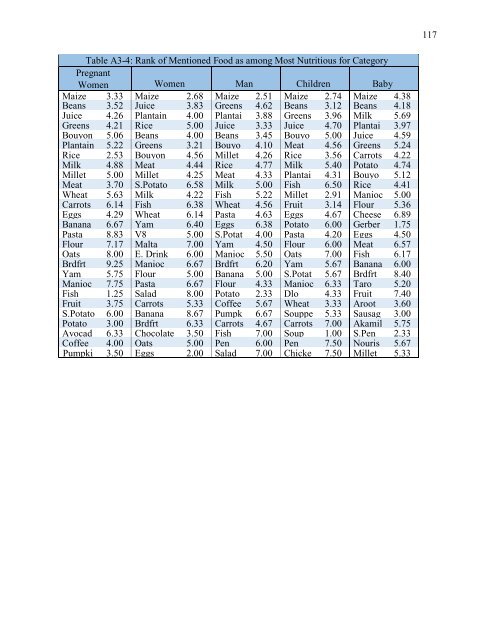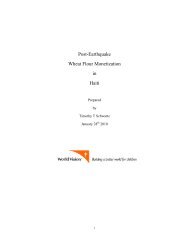Food Consumption Patterns Part 2
Create successful ePaper yourself
Turn your PDF publications into a flip-book with our unique Google optimized e-Paper software.
115<br />
<br />
<br />
<br />
<br />
<br />
sauce. Ginger goes with sweets, as does cinnamon, star anise (Illicium verum), and fey d’inde.<br />
On the other hand, bullion cubes, cloves, peppers, parsley, leeks, tomato paste, onion and<br />
salt are almost all—or at least a minimum combination of them--indispensable ingredients<br />
in meat and fish sauces.<br />
Bread was omitted even though we did keep soup-pen (bread soup). The reason is because<br />
it is highly misleading to mention bread as a distinct category. Bread was often not<br />
mentioned when in fact we know that it is one of the most consumed foods, particularly in<br />
urban areas. Anecdotally we know that bread is almost always eaten with coffee and<br />
chocolate and akasan. The pattern is so consistent that it is almost inconceivable to<br />
consume these liquids in the absence of bread. People will also commonly and traditionally<br />
eat bread with juice, sugar water or even soda. Yet, during the freelist interviews no<br />
respondent mentioned bread in the context of these liquids. In this regard it would be<br />
interesting to clarify in subsequent research to what degree cookies and crackers have<br />
supplanted bread as a snack food.<br />
The same taking-for-granted of common foods appears true for mangos and perhaps sweet<br />
potatoes and bread fruit. They were commonly left out of respondent lists. We suspect<br />
same might be true regarding peanuts and peanut butter. They may be so much a part of<br />
the diet that people simply took them for granted and failed to mention them. On the other<br />
hand, it is clear that they are not recognized medicinal types foods in cases of illness or<br />
acute nutritional need. Only one of the fifty people interviewed mentioned peanut butter.<br />
Other food dimensions that are touched on in the following but that may warrant greater<br />
development in the subsequent stages of the research are the dimensions, 1) sweet, salty,<br />
spicy and sour, and 2) hot vs. cold. Indeed, it may be useful to explore a type of<br />
multidimensional categorization of food types, associations and rules along these lines as<br />
well as how they are prepared, liquid, paste, powder or solid if they are natural vs.<br />
manufactured, and local vs. imported .<br />
Another entire realm of foods are those made of imported wheat. These foods are present<br />
in the analysis and are given their prominent role in the Haitian diet. But they could be<br />
analyzed as their own complex category of foods. We have provided that analysis but, for<br />
the time being, relegated it to another annex.<br />
In short, the food system is complex and we are not able to present all rules and all<br />
relationships at this stage. But the following analysis is nevertheless extensive, helps make<br />
sense of Haitian culinary patterns, carries us a long way toward identifying where the<br />
consumption of peanuts can be promoted and expanded in the Haitian dietary regime, and<br />
it lays the foundation for complete profile of culinary rules and consumption patterns in<br />
the subsequent stage of investigation.
















